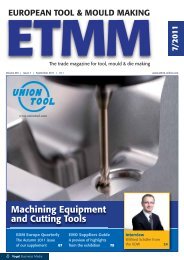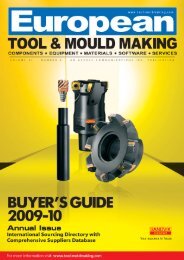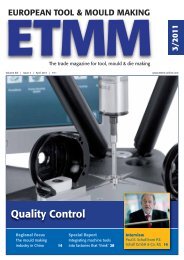Hot Runners and Mould Components - ETMM-Online
Hot Runners and Mould Components - ETMM-Online
Hot Runners and Mould Components - ETMM-Online
Create successful ePaper yourself
Turn your PDF publications into a flip-book with our unique Google optimized e-Paper software.
34<br />
Case Studies<br />
Using a Powerful Yet Sensitive<br />
Tryout Press to Finish the Job<br />
Tryout presses are an essential link in the production chain for mould builders.<br />
One mould maker needing to try out large moulds found its ideal supplier.<br />
More <strong>and</strong> more mould makers<br />
are relying on tryout presses<br />
to set their injection moulds<br />
perfectly. Koller Formenbau und<br />
Kunststofftechnik GmbH in Oberbürg,<br />
Germany, for example, uses<br />
a Blue Line MIL 303 tryout press<br />
with a 3,000-kN clamping force.<br />
This machine was manufactured<br />
by Millutensil S.r.l. <strong>and</strong> supplied<br />
by the Italian company’s German<br />
agent Dremo Werkzeugmaschinen<br />
GmbH (www.dremo-wzm.de).<br />
Tryout presses don’t make<br />
anything, but they are an essential<br />
link in the production chain.<br />
“Today, many OEM manufacturers<br />
explicitly require that mould<br />
suppliers wishing to bid against<br />
public tenders for bumper moulds<br />
should be equipped with least one<br />
2 x 3-m spotting press,” explains<br />
Max Koller, CEO of Koller Formenbau<br />
und Kunststofftechnik.<br />
“Naturally, a press is not an item<br />
that one can directly invoice, but<br />
it is now often a prequalification<br />
requirement.”<br />
High-precision mould machining<br />
is incomplete without a tryout<br />
press these days. To make his point<br />
clear, Max Koller declares milling<br />
down to “zero” a dream. “Particularly<br />
with very large moulds,<br />
the last hundredths are obtained<br />
with a spotting press,” he declares<br />
unequivocally. Some companies<br />
use a crane to set half-moulds<br />
(“detrimental to exact edges,”<br />
warns Koller) <strong>and</strong> others try out<br />
the mould directly on the injection<br />
press. But in adopting such<br />
approaches, says Koller, “they<br />
cannot work exactly or easily.”<br />
The mould punch rotates 180° <strong>and</strong> is thereby set to the best operating positions by the press.<br />
No Compromises<br />
Using a crane to try out a mould<br />
precludes simulation of injection<br />
forces. And trying out the mould<br />
on the injection press requires<br />
accounting for the half-moulds<br />
<strong>and</strong> the force of gravity preventing<br />
them from aligning parallel to<br />
the machine. Max Koller’s thinking<br />
is this: “The outcome will<br />
never be good enough, especially<br />
as the advancement of injection<br />
presses is typically a jerky motion.<br />
Furthermore, trying a mould out<br />
on an injection press is simply<br />
way too expensive. And at last,<br />
European Tool & <strong>Mould</strong> Making | May 2011 | www.etmm-online.com












